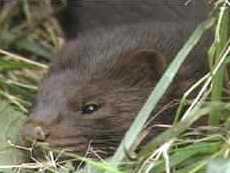
Report from Chris Smith
Mink Eradication Project Imports Bait
By Andrew Black, Scottish Press Association in the Scotsman 27 th January 2004

Scientists running a project to eradicate mink in the Western Isles
have had to import bait from Canada, Scottish Natural Heritage said today.
The operation was set up two years ago because of the damage the
animal was doing to native wildlife, particularly protected ground
nesting birds in the Uists.
The bait, made from the mink's scent glands, was previously provided
by the project itself but production can no longer keep up with the
increased number of traps now being used.
Dr Sugoto Roy, co-ordinator of the mink eradication project, said: "We
use a variety of different bait, which in the past has predominantly
been fish, in order to attract mink into the traps.
"It is inevitable using this method that other animals with a taste
for fish, for example, rats and ferrets, will also find their way into
the traps.
"Trapping these non-target species interrupts the mink trapping effort
by spoiling bait and making traps unavailable to mink overnight."
Dr Roy added: "Bait containing mink scent glands has shown to be an
effective means of attracting mink without also encouraging other
species into the traps.
"However, with the number of traps now in use by the project standing
at 2,400, we simply don't have enough of the scent gland bait to go
around and are still using alternatives, such as fish and occasionally some of the rats we catch."
It is hoped the consignment from Canada will improve the efficiency of
the trapping effort by catching more mink and fewer non-target species.
Since the European-funded Hebridean Mink Project was set up to wipe
out the non-native species from the Uists and significantly reduce
numbers in the south of Harris, 421 of the animals have been caught.
The project has also set up several studies to look at the ecology and
habits of mink and how remaining animals react to their eradication.
The project has also planned a major spring trapping operation
concentrating on North Uist and the islands in the Sound of Harris,
with the deployment of 15-20 trappers and more than 500 traps.
A PhD study set up as part of the project will also monitor movements
of mink, assessing population densities and identifying dens and
feeding areas.
Mink, which are not native to the UK, pose particular threats to wild
birds as they eat eggs, chicks and adult birds from internationally
important bird sites.
The Uists include some of Europe's most important bird sites which the
UK is required to protect.
© The Scotsman, 27 th January 2004
 |
 |
 |
| Return to index | Return to Exotic Scottish Animals | Return to American Mink |